If you love to spend time in the outdoors, particularly your own backyard, you may be wondering, how to cut branches from a tall tree. After all, many of us are aware that pruning is a big part of being a responsible home owner. Nonetheless, it can certainly be a job that gets put down the bottom of the priority list – especially if you’re like me and love hearing the sound of birds chirping birds amongst the tree branches in the morning. Plus it can be super hard knowing that those same branches probably make the perfect habitat for those birds you love seeing and hearing about the place. And trees with decent branches offer shade to your family and pets and add volume and greenery to your outdoor area.
Still, there may come a time when it dawns on you that those large branches you admire, look like they might fall any minute and be weaponized by gravity. If this is the case, it definitely would be best to get rid of them before any injuries are sustained or damages incurred. So if you are wondering how to cut branches from a tall tree, this is the perfect guide to get you started on trimming up trees that need it.
When is the right time for cutting off limbs and branches?
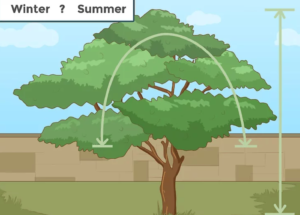
This is not always the easiest thing to determine. In some cases, it could be an immediate threat and if this is the case, don’t worry about what season it is. In others, it could only be for aesthetic purposes. However, if your tree looks like it going to pose a danger with overhead power lines, that is a good point to start trimming it. Also, if the branch is rotten and dried up, the potential damage or injury to be caused when it falls is high.
You may want to wait for winter.
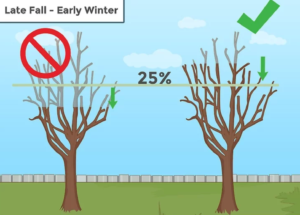
At this time, the tree will easily survive any cuts you make to branches. There is less chance that the tree will contract a disease during this time. Plus pruning in the winter will result in an explosion of growth during the spring. It is worth noting that cutting branches during the summer will slow the growth of the cut branch. This is a good strategy if you’re trying to shape your tree or slow the growth of branches you don’t want.
Many pests will be safely tucked away for the winter so it is often a popular time to cut large branches.
Important Tips:
Each cut you make compromises the tree protection system and opens the tree to potential fungus and insect infestation. Prune only as much as you absolutely need to prune, and never remove more than 25 percent of a tree’s branches.
- For most deciduous trees, make sure that there are living branches on at least 2/3 of the tree, though this varies by species. Be aware that the trunk alone is not enough to ensure that the tree will survive. Removing all the branches is highly stressful for the plant.
- Don’t prune heavily more than once per season. Unless a storm breaks more branches, you shouldn’t prune more than once, since the tree needs time to
Tools Needed to Cut Branches from a Tall Tree
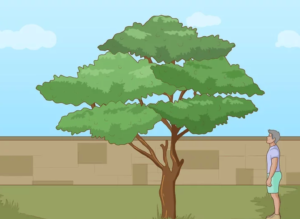
There are several tools needed to cut branches from a tall tree. It all depends on the exact use you want to put them to. To this end, we would recommend:
1. Pruning shears.
These are perfect for the little branches and twigs that measure up to an inch in diameter. Pruning shears tend to look like a pair of scissors, but more interesting designs are available if you would want one.
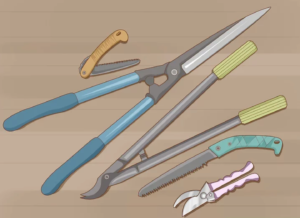
2. Pole pruner.
While you are on the ground, or on a strong branch of a tree, there are branches that you would like to reach but are not easily accessible due to the distance. A pole pruner will easily reach those branches that are 10 to 15 feet away from you. The best option for you is to get a pruner that has a bypass blade as well as a pruning saw as art of the package. These will help deal with branches that are up to 2 inches thick in diameter.
3. A saw.
These come in various shapes and sizes. They are the best tools for cutting off larger and thicker branches. The most widespread of these are the Chainsaw. They are virtually easy to get at a hardware store but the costs could put you off.
For something truly multifunctional, a Sawzall, also known as a reciprocating saw, will help you get the job done at an easier cost.
How To Cut Branches From A Tall Tree – Step by Step Instructions
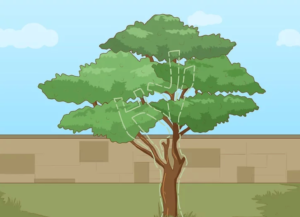
Even if you have never done it before, you probably already know what you need to do. However, there is a very big difference between something you have seen getting done, and doing that thing yourself.
For this task, it is best to get some safety equipment and a few tools. These include:
· Safety goggles, dust mask and ear plugs.
· Safety harness.
· Tripod ladder.
· Saw.
· Pruning pole and clippers.
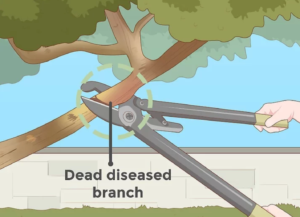
1. Remember that safety is paramount.
You may have climbed up trees in your earlier days and you are probably thinking muscle memory will kick in. It may, but this is not like riding a bicycle. You are much more likely to suffer a serious and permanent injury from falling out of a tree.
To this end, a tripod ladder is necessary to maintain balance. If on soft ground, drive in the spikes on the leg bottoms for added stability.
Next, the safety harness is meant to keep you from falling off the tree in case you lose your grip or a branch or pieces of bark give way under your weight.
Before getting up the ladder, you must have your safety goggles, dust mask and ear plugs on. These will keep you safe from the effects of the saw while cutting the branches.
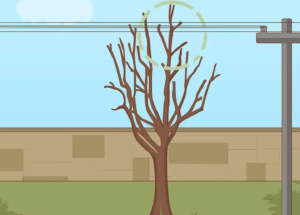
2. Check your workspace.
There are a lot of hazards involved when cutting up a tree. Dead branches could easily give way, and pieces of bark waiting for the right amount of pressure, can also give way. Branches could also be hiding covered power lines, so be mindful of those.
Before getting up the tree, use the pruning pole to inspect areas necessary for your task. Check branches and other potential dead areas. The power lines are paramount here. Note them and keep them in mind when you are working.
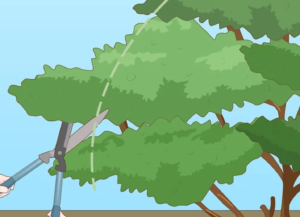
3. Cut away small branches
Cut away the little branches and the dead parts of the tree. The pruning clippers are great, but only for small parts of the tree. Clearing these parts will give you clear access to the branches you want to use the saw on.
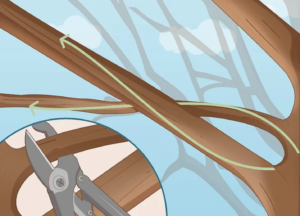
4. Time for the saw
Once the distractions are out of the way, it’s time to get down to the real meat of the business. It’s time to use a saw. The type you use will determine how effectively you will get the job done. A Chainsaw will get the job done with ease.
If you don’t have access to a chainsaw, a Sawzall will still get the job done beautifully.
All you need to do is make straight cuts across the branches that you want to get rid of. Mark the point where you want to make the cut. Directly to the bottom of the branch a small notch. When you begin cutting, this notch will help the branch pull away from the saw instead of locking up on it.
5. Remove branches that cross
Remove branches that cross, then open the plant so that air might circulate and light reach all parts of the plant. In order for trees to grow healthy, they need good air circulation through and around the branches. Branches that are close together foster the growth of fungus and attract more insects.
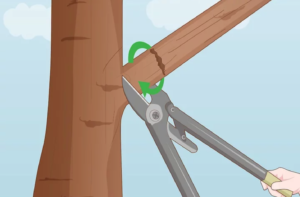
6. Be mindful of the Stem Collar
The cut should be made on the branch side of what is called the stem collar. This is the small lip of bark that each branch protrudes from. You want to leave the collar intact, so don’t cut flush with the trunk.
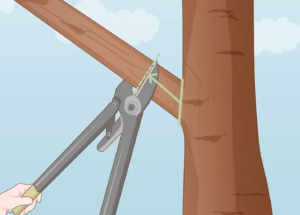
7. Cut Through the Branch
Your second cut will saw through the branch, on the outside (further from the trunk) of the first cut you made. Remove the branch from the area and what you have left is a stub.
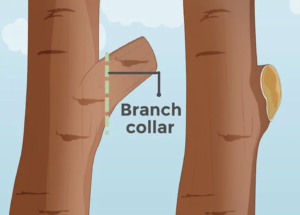
8. Make Another Cut Against the Stem Collar
Now you can make another cut almost right against the stem collar. This gives the tree the best chance of healing in a quick, healthy way. Be sure you don’t actually cut off the branch collar. This must remain intact.
9. Clean Up Debris Left Behind
Of course, while you were rattling the branches, pieces of saw dust were flying all over. Dead leaves are perhaps the biggest giveaway that some work was being done. You could be the kind that lets them mulch at the roots of the tree but if you aren’t, you have to get rid of them.
A leaf blower will help you clean up. You don’t have to use any you come across. You might want to check out our article on, the Most Powerful Handheld Leaf Blower for some cleaning up tips here.
10. Clean Pruning Equipment
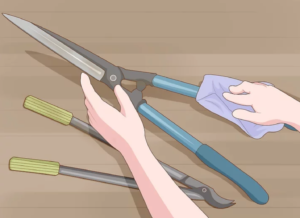
Although you may not think it necessary to disinfect your pruning equipment, if you have cankers and obviously diseased portions of trees, it probably is better to be safe and disinfect your pruning tools with rubbing alcohol (or any household cleaner) after each cut of a diseased tree.
Interested in our other articles? Check out
